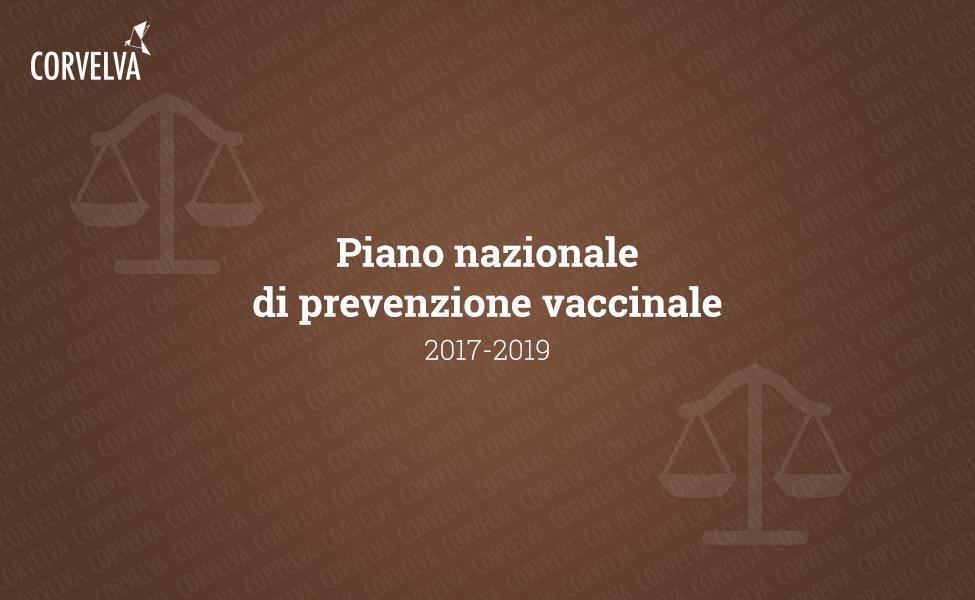National vaccine prevention plan 2017-2019

The 2017-2019 National Vaccine Prevention Plan (Pnpv) was approved at the State-Regions Conference on 19 January 2017 and published in the Official Journal the following month (OJ General Series, n.41 of 18 February 2017).
The Pnpv, and the related vaccination calendar, have the primary purpose of harmonizing "the vaccination strategies in place in the country, in order to guarantee the full benefits deriving from the population, regardless of the place of residence, income and socio-cultural level. from vaccination, intended both as an individual protection tool and as a collective prevention tool, through equity in access to high quality vaccines, also from a safety point of view, and available over time (preventing, as far as possible, shortages) , and excellent immunization services. "
Furthermore, since all the vaccines contained in the 2017-2019 Pnpv calendar have been included in the Decree of the President of the Council of Ministers (Dpcm) defining the new essential levels of assistance (Lea), citizens, who fall into the target categories for vaccination, have the right to use it for free, according to scheduled scheduling (Dpcm of 12 January 2017 published in the Official Journal on 18 March 2017).
The Pnpv, in addition to presenting the new National Calendar of vaccinations actively and free of charge offered to the population by age group, contains chapters dedicated to vaccination interventions intended for particular risk categories (by pathology, by occupational exposure, for occasional events) and identifies some priority areas of action (aligned with the documents produced in this regard by the WHO: "Decade of Vaccines 2011-2020" and Evap), a series of specific objectives and related monitoring indicators.
The goals
The objectives identified by the 2017-2019 National Vaccine Prevention Plan are:
1. keep the state polio free (WHO European Region has reached it polio free status in 2002)
2. reach the state measles free e rubella free (pursuing the objectives of the National Plan for the Elimination of Measles and Congenital Rubella and strengthening the actions for the elimination)
3. guarantee the active and free offer of vaccinations in the indicated age groups and in the population groups considered at risk
4. increase awareness of vaccination in the general population, including by conducting vaccination campaigns to consolidate vaccination coverage
5. fight inequality by promoting vaccination interventions in marginalized or particularly vulnerable groups of populations
6. complete the computerization of vaccination registries, at regional and national level, interoperable with each other and with other databases (infectious diseases, adverse events, resident / assisted)
7. improve surveillance of vaccine-preventable diseases
8. to promote, in the general population and healthcare professionals, a culture of vaccinations consistent with the guiding principles of the Pnpv, described within the document as "10 points for the future of vaccinations in Italy" (safety, efficacy, efficiency, organization , ethics, training, information, investment, evaluation, future)
9. support, at all levels, the sense of responsibility of health workers, employees and affiliated with the National Health Service (Ssn), and full adherence to the purposes of collective health protection, which are achieved through vaccination programs, providing adequate sanctioning actions if a default behavior is identified
10. activate a process of revision and standardization of the criteria for identifying the causal link for the purpose of recognizing compensation, pursuant to law 210/1992, for those affected by vaccination, involving the other competent institutions (Ministry of Defense )
11. to foster, through collaboration between national institutions and scientific societies, independent research and scientific information on vaccines.
The Plan does not refer to the specific characteristics of each vaccine in consideration of the scientific and technological evolution of the sector; on the other hand, it recommends reaching the maximum possible protection in relation to the prevalent epidemiological profile and the spread of the strains.
The new vaccinations
In addition to vaccinations for which, for years, national immunization programs have been planned (diphtheria, tetanus, polio, hepatitis B, Haemophilus influenzae b, whooping cough, pneumococcus, measles, mumps, rubella, meningococcus C in newborns, HPV in 11 year old girls and flu in subjects aged ≥65 years), the Pnpv 2017-2019 introduces vaccinations in the vaccine calendar and consequently also in Lea anti-meningococcus B, anti-rotavirus and anti-chickenpox in newborns; anti-HPV in 11-year-old males; the tetravalent anti-meningococcal vaccine Acwy135 and the anti-polio booster with IPV in adolescents; pneumococcal vaccination (PCV13 conjugate + PPV23 polysaccardic) and vaccination against Herpes Zoster in 65-year-olds.
Note:
The Pnpv 2017-2019 was carried out in collaboration with all the institutions and scientific societies involved in vaccination strategies: Higher Institute of Health (ISS), Italian Medicines Agency (AIFA), Regions, Italian Hygiene Society (Sites), Federation Italian general practitioners (Fimmg), Italian Federation of Pediatricians (Fimp), Italian Society of Pediatrics (Sip).
Download: PNPV 2017-2019

